| 1 | Found in the hottest US deserts |
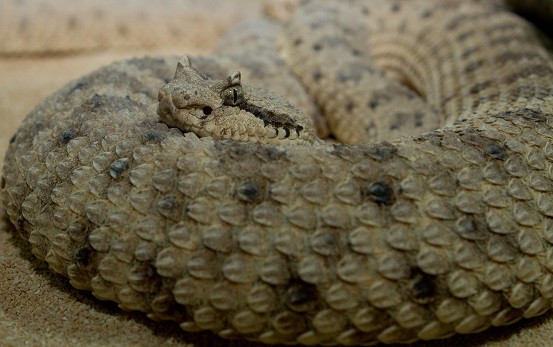
North America has 45+ species of rattlesnake, each with its own speciality. The west diamondback bites the most people, while the tiger rattlesnake has the deadliest venom drop for drop. The sidewinder’s speciality is dwelling in the most brutal, remote environments: the scorching heat of the desert. Sidewinder rattlesnakes inhabit 4 US states, including western Arizona, southeast California, southern Nevada, and southwest Utah. Within those states, they can be found on arid plains, desolate canyons, and even sand dunes.
Sidewinder rattlesnakes live so remotely that despite their mid-ranking venom, deaths are almost unheard of because nobody ever meets them. You’ll never find a sidewinder living under your porch unless you happen to be a desert hermit. Remote trekkers are a rare group to meet them occasionally, and they’re commonly found in Death Valley, the hottest place on Earth (reaching 57 degrees in July 1998). This snake is particularly concentrated in the Mesquite Flats Sand Dunes, one of the most famous landmarks within the valley.
You’ll rarely find sidewinders above 1200 metres in altitude, as their mountain navigation skills are very poor. Sidewinders rarely interact with each other except for mating, but in the species’ hotspots, the density can be one snake per hectare.
| 2 | They sidewind to avoid burns |
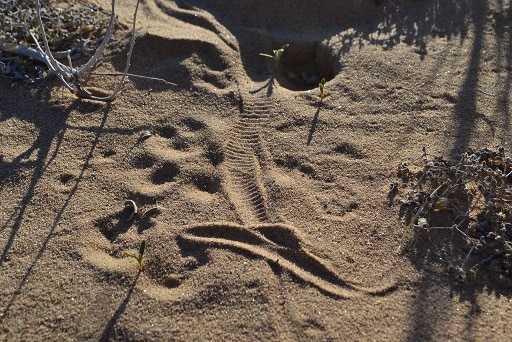
It’s easy to tell whether a sidewinder rattlesnake lives nearby, as the species leaves a series of J-shaped imprints wherever it goes. This comes from their signature sideways mechanism of motion, which they share with less than 10 unrelated “sidewinder” species worldwide (including the Saharan horned viper).
Most snakes move forwards, either in a straight line like a boa constrictor or in S-shapes like a garter snake. Instead of leading with their heads, the sidewinder leads with the centre of its body. On sandy surfaces, they can travel sideways at 18mph, thanks to flatter, smoother scales on their bellies which reduce friction.
In motion, the effect looks uncanny, as though the sidewinder is hovering a couple of centimetres above ground. They kind of are, because the sidewinding locomotion evolved to prevent its body from touching the roasting desert floor. At any given time, only two small portions of the sidewinder’s body will make contact with the ground. If a human walked barefoot on the average sidewinder habitat, their feet would probably burn within seconds.
| 3 | Unusual camouflage for a snake |
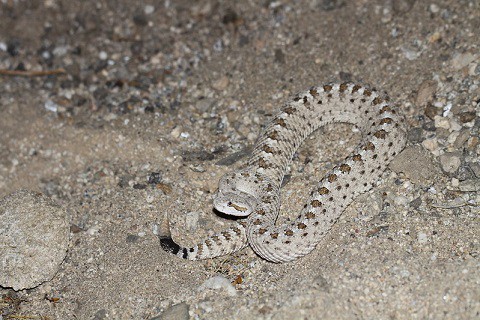
Another desert adaption of the sidewinder is fleshy horns above each eye, a unique feature among rattlesnakes. It’s believed that these “horns” shield the snake’s eyes from the glaring sunlight, like the peak of a cap, preventing them from blindness.
An old folklore tale revolves around these horns: that if one of them pierces your skin, you’ll die instantly. In reality, the sidewinder’s horns are soft, and incapable of tearing human flesh.
The sidewinder is also a master of camouflage, as their sandy coloured scales disguise them from geckos and birds. Better yet, sidewinders can change the colour of their scales. This ability is called metachrosis, and is common in lizards, but almost unheard of in snakes. During summer, the sidewinder’s scales are as light as ever, but when winter arrives, the lack of sunlight triggers a rise in melanin. The sidewinder’s scales darken, leading to higher sunlight absorption and keeping its bodily temperatures in fine balance.
| 4 | Life in the punishing desert |

Another sidewinder survival trick is varying its sleeping habits. During winter, they mainly hunt by day, but when summer arrives, when the sun reaches its highest point and bares down on their backs with sizzling intensity, the sidewinder becomes exclusively nocturnal.
This adds a small problem – tracking down its prey. But like many vipers, the sidewinder has heat-sensing pits in its head which grant it a form of infrared vision. Once full, the sidewinder will lie around motionless for 5-10 days – a natural consequence of eating food 3 times wider than its own body.
Sidewinders constantly need to cool off, particularly at midday. They’re poor diggers, and usually seek refuge in a ready-made mammal burrow or rocky crevice instead. That’s the natural method at least, but sidewinders will also take shelter in abandoned mines (treasure hunts beware).
Sidewinders have the largest home range of any rattlesnake, encompassing 23 hectares. One survey found that males and females travelled 185.4 and 122.9 metres in an average day respectively.
| 5 | Their venom is fairly weak |
If you’re ever lost in the desert after a treasure hunt gone wrong, and you accidentally step on a sidewinder, then don’t worry. Sidewinder venom is powerful enough to wipe out mice or lizards, but almost certainly not a human.
For example, the Mojave rattlesnake has an LD50 toxicity measurement of 0.18mg in mice, which is far stronger than the sidewinder’s 2.6-5.5mg. Its venom possesses a notoriously deadly neurotoxin called Mojavetoxin which is found in no other rattlesnake. A sidewinder’s bite, with its front teeth tightly connected to two venom glands, delivers 18-63mg of venom per bite. The western rattlesnake can inject up to 250mg.
Because of the sidewinder’s remoteness, we know less about its typical effects, but the bite can unleash blisters, pain and swelling. Nothing life threatening then, but other reports are worse, including black, necrotic lesions surrounding the wound as the skin rots away.
That said, the most venomous snake in America is the tiger rattlesnake, with an LD50 score of 0.08mg in mice. In a pitched arena battle, it’s obvious who would win.
| 6 | The 5 day bite cycle |
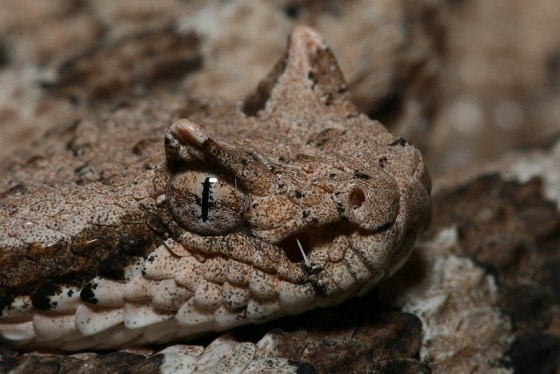
This case study from 2014 shows a typical example of a sidewinder bite. The victim was a 56 year old worker, minding his own business in southwest Arizona. He wasn’t an overconfident reptile enthusiast, and he wasn’t camped out in the middle of nowhere. One day, the man felt a painful bite through his right leather boot, and quickly noticed a rattlesnake in front of him, which he identified as a sidewinder by the fleshy horns and sideways slithering motion. Almost instantly, the man felt a burning sensation in his right foot. His toes went numb, and he felt a wave of nausea which disappeared after 60 minutes.
During day 2 in hospital, the man’s symptoms suddenly progressed. His entire left leg was tingling and weak, and there was a burning pain all the way up to the groin. The weakness had now spread to the right half of his upper body. The man could barely walk, and was so nauseous that eating was impossible.
By day 3, the doctors were concerned that his lungs might fail and cause respiratory failure. The doctors still hadn’t administered antivenom, but their gamble paid off in the end, as on day 5, the man was discharged with only a cane to keep him steady.
| 7 | Diet of a sidewinder rattlesnake |
A sidewinder’s diet consists of any animal daring enough to live in the Arizona desert. 50% consists of lizards, but mice, gophers, house sparrows, glossy snakes, and western ground snakes are also confirmed. One particular favourite is the kangaroo rat, a hopping species native to southern Arizona. This cuter-than-average rat has a long tail, and hops in a very similar way to real kangaroos (travelling up to 7 feet per jump). They appear to be defenceless, but this youtube video captured by night vision tells a different story.
It shows a sidewinder sitting coiled in the undergrowth, while a kangaroo rat stands watchfully approximately one foot away. What could possibly go wrong? The outcome seems inevitable, but just as the disguised snake springs from its coils, read to inject its venom, the kangaroo rat pulls of a surprise manoeuvre. It jumps into the air with perfect timing, and tuck its feet in.
Milliseconds later, it kicks the lunging sidewinder square in the head, dispatching its enemy and propelling itself halfway in the opposite direction in one efficient move. Sidewinders are crafty snakes, but they’re not infallible.
| 8 | They’re gullible |
Another tasty morsel on the sidewinder’s menu is the banded gecko, and this is another species that commonly outwits it. This gecko also resides in southwest Arizona and southeast Nevada, and could easily be called the leopard gecko, as its brown and yellow patterns bare a strong resemblance. At 4-6 inches long, it’s a perfect snack for the sidewinder to eat – in theory.
This 4 minute video shows an all too common outcome. It begins with a sidewinder slithering majestically across the desert dunes like a scene from Lawrence of Arabia, before cutting to a banded gecko basking in the warm sunlight. Many gecko species change colour when exposed to UV radiation in order to camouflage, and as the sidewinder approaches, the gecko stays perfectly still. The gecko appears to be directly in the snake’s plain of vision, but instead, the sidewinder slithers on past.
The gecko holds its nerve with a will of steel, until at the last moment, the sidewinder stops, as though it can sense something. For a few seconds, the snake’s tail remains in shot, only a few millimetres from the statue-like gecko’s face. Finally, the sidewinder slithers away, and the gecko lives to tell the tale.
| 9 | Females have a very short lifespan |
The sidewinder rattlesnake gives it everything to survive in the harsh desert, but this extreme habitat comes with a cost. Female sidewinders have an unusually short lifespan, averaging at just 5 years. Giving birth in the desert puts a catastrophic strain on their bodies, sometimes causing them to drop dead on the spot. Male sidewinders fare far better, typically living for 13 years in the wild.
In captivity, sidewinders can live for 20 years, but keeping them as pets is banned in three states: Kansas, Arizona and Delaware. Sidewinders are particularly hard to control in captivity, even refusing to eat food handed to them, unlike the relaxed boa constrictor or red-bellied black snake. They also require extremely low humidity, to mimic their desert habitat to the letter.
Sidewinders are nothing special for length, clocking in at 43-76cm. As they spend all day slithering around an isolated desert hellscape where no man can hope to survive, being small probably reduces their requirement for water. They’re significantly shorter than the grass snake at 80-100cm, citizen of the comfy English countryside.
| 10 | Mothers are unusually caring |
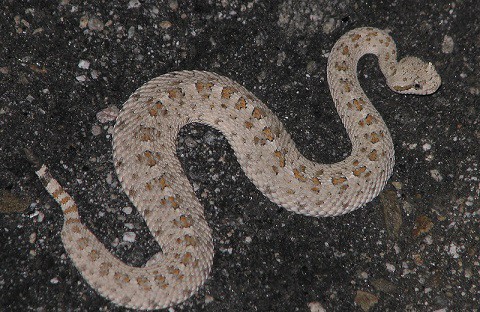
There isn’t a single snake species that guides its young around the jungle like a mother bear and teaches them to slither up trees, but the sidewinder is more caring than 90%. Sidewinders give birth in cool, sheltered spots, such as the mammal burrows they rest in during the day. They give birth to live young encased in a thin, breakable membrane, usually in clusters of 10-20.
For several hours after they emerge, the mother sidewinder will guard her offspring. She will dutifully stand watch, and do everything in her power to prevent enemy predators from sinking their claws into her babies. Afterwards, she’ll pay less attention, but remain in the same burrow for 7-10 days.
The hatchling snakes themselves have another weird story. To regulate their temperature, dozens of baby sidewinders will huddle together at once, in a slithering ball-shaped mass at the burrow’s entrance. Using subtle snake manoeuvres, this gives them the perfect balance of temperature, between the intense heat of the desert and the cool air pockets inside. Snakes will often move from the back of this ball to the front, and vice versa.
| !! | Bonus: scale microstructure |
In 2021, scientists discovered more microscopic physical differences which explained why a sidewinder moves the way it does. They produced a dried out skin sample, which they analysed in extreme detail using an atomic force microscopic. The team also developed mathematical models, to predict how different scale structures would interact with different habitats.
In most snakes, their bellies are covered with microscopic spikes, which are orientated from head to tail. These create a friction between snake and ground, which allows them to defy logic and move freely without arms and legs. The sidewinder’s meanwhile, were covered in microscopic pits. Spikes in snakes are designed for forward motion, while pits are more flexible, allowing them to move in any direction. It grants them more friction on each flank, as well as forward, which they can exploit to ride along. These structures are all invisible to the naked eye.
The sidewinder’s scale microstructure was less evolved than two African desert-dwelling snakes, the horned viper and Namib desert adder. These had lost all their spikes, whereas the sidewinder still had small vestigial spikes as a leftover from its rattlesnake ancestors.